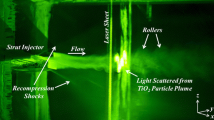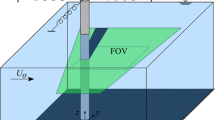Abstract
The vortex-based propulsive systems’ enhanced performance greatly contributes to the vortex added-mass effect, which was initially developed to explain the added drag when a solid body accelerates in fluids. However, the solution of the instantaneous vortex added-mass coefficient is still remaining a question because vortices always do not have a stable geometric shape like solid bodies. In this paper, the formation of a canonical vortex ring is performed to investigate the nature of vortex added-mass and explore a solution for estimating the vortex added-mass coefficient. The vortex ring is generated by a piston-cylinder apparatus, and the time-dependent flow fields are recorded by particle image velocimetry technique. The ridges of finite-time Lyapunov exponent are applied to identify the Lagrangian boundary of the vortex ring. It is found that a part of the ambient fluids is entrained by the vortex ring when it propagates downstream, resulting in the growth of the vortex ring. Besides, a significant drift of the ambient fluid is observed to bypass the Lagrangian boundary of the vortex ring and reveals the nature of the vortex added-mass. Thus, the added-mass coefficient of the vortex is redefined as the ratio of the volume of the Lagrangian drift fluids in finite time interval step to the vortex volume at that instant. By referring to McPhaden’s method to estimate the added-mass of a solid body, a method based on the multiple material lines with relative-timestep is developed to estimate the volume of Lagrangian drift fluids induced by the vortex added-mass. Then, an empirical criterion for determining the material line number and the finite time interval step is suggested for the vortex ring flow, and the eventual vortex added-mass coefficient calculated by the volume of Lagrangian drift fluids is found to well agree with the results of Brennen. Moreover, the method based on multiple material lines for calculating Lagrangian drift fluids’ volume suggests a potential solution for estimating the added-mass coefficient of arbitrary vortex structures.
Similar content being viewed by others
References
Ruiz L. A., Whittlesey R. W., Dabiri J. O. Vortex-enhanced propulsion [J]. Journal of Fluid Mechanics, 2011, 668: 5–32.
Whittlesey R., Dabiri J. O. Optimal vortex formation in a self-propelled vehicle [J]. Journal of Fluid Mechanics, 2013, 737: 78–104.
Darwin S. C. Note on hydrodynamics [J]. Proceedings of the Cambridge Philosophical Society, 1953, 49(2): 342–354.
Peng J., Dabiri J. O. An overview of a Lagrangian method for analysis of animal wake dynamics [J]. Journal of Experimental Biology, 2008, 211(2): 280–287.
Jie L. I., Lu C., Huang X. Calculation of added mass of a vehicle running with cavity [J]. Journal of Hydrodynamics, 2010, 22(3): 312–318.
Brennen C. E. A review of added mass and fluid inertial forces [R]. Sierra Madre, CA: USA: Lewis Courts 1982.
Liao J. C., Beal D. N., Lauder G. V. et al. Fish exploiting vortices decrease muscle activity [J]. Science, 2003, 302(5650): 1566–1569.
Liao J. C., Beal D. N., Lauder G. V. et al. The Kármán gait: Novel body kinematics of rainbow trout swimming in a vortex street [J]. Journal of Experimental Biology, 2003, 206(6): 1059–1073.
Zhang Y. N., Xu Q., Chen F. P. et al. A selected review of vortex identification methods with applications [J]. Journal of Hydrodynamics, 2018, 30(5): 767–779.
Dabiri J. O. Note on the induced Lagrangian drift and added-mass of a vortex [J]. Journal of Fluid Mechanics, 2006, 547(-1): 105–113.
Eames I., Belcher S. E., Hunt J. C. R. Drift, partial drift and Darwin’s proposition [J]. Journal of Fluid Mechanics, 2006, 275: 201–223.
McPhaden C. J., Rival D. E. Unsteady force estimation using a Lagrangian drift-volume approach [J]. Experiments in Fluids, 2018, 59: 64–75.
Saffman P. G. The self-propulsion of a deformable body in a perfect fluid [J]. Journal of Fluid Mechanics, 1967, 28: 385–389.
Qin S., Liu H., Xiang Y. On the formation modes in vortex interaction for multiple co-axial co-rotating vortex rings [J]. Physics of Fluids, 2018, 30(1): 011901.
Xiang Y., Lin H., Zhang B. et al. Quantitative analysis of vortex added-mass and impulse generation during vortex ring formation based on elliptic Lagrangian coherent structures [J]. Experimental Thermal and Fluid Science, 2018, 94: 295–303.
Xiang Y., Liu H., Qin S. et al. A unified energy feature of vortex rings for identifying the pinch-off mechanism [J]. Journal of Fluids Engineering, 2018, 140(1): 011203.
Dang C. H., Wang J., Liang Q. Inflows/outflows driven particle dynamics in an idealised lake [J]. Journal of Hydrodynamics, 2019, 31(5): 873–886.
Haller G. Lagrangian structures and the rate of strain in a partition of two-dimensional turbulence [J]. Physics of Fluids, 2001, 13(11): 3365–3385.
Haller G. Finding finite-time invariant manifolds in two-dimensional velocity fields [J]. Chaos: An Interdiplinary Journal of Nonlinear Ence, 2000, 10(1): 99–108.
Shadden S. C., Dabiri J. O., Marsden J. E. et al. Lagrangian analysis of fluid transport in empirical vortex ring flows [J]. Physics of Fluids, 2006, 18(4): 047105.
Olcay A. B., Krueger P. S. Measurement of ambient fluid entrainment during laminar vortex ring formation [J]. Experiments in Fluids, 2008, 44(2): 235–247.
Dabiri J. O., Gharib M. Fluid entrainment by isolated vortex rings [J]. Journal of Fluid Mechanics, 2004, 511: 311–331.
Dabiri J. O. On the estimation of swimming and flying forces from wake measurements [J]. Journal of Experimental Biology, 2005, 208(18): 3519–3532.
Benjamin T. B. Note on added mass and drift [J]. Journal of Fluid Mechanics, 2006, 169: 251–256.
Fraenkel L. E. Examples of steady vortex rings of small cross-section in an ideal fluid [J]. Journal of Fluid Mechanics, 1972, 51: 119–135.
Author information
Authors and Affiliations
Corresponding author
Additional information
Projects supported by the National Natural Science Foundation of China (Grant Nos. 91441205, 91941301), the China Postdoctoral Science Foundation (Grant No. 2018M642007).
Biography: Shu-jia Lin (1995-), Female, Master
Rights and permissions
About this article
Cite this article
Lin, Sj., Xiang, Y., Li, Zq. et al. Evolution of the Lagrangian drift and vortex added-mass of a growing vortex ring. J Hydrodyn 33, 725–735 (2021). https://doi.org/10.1007/s42241-021-0064-2
Received:
Revised:
Accepted:
Published:
Issue Date:
DOI: https://doi.org/10.1007/s42241-021-0064-2




